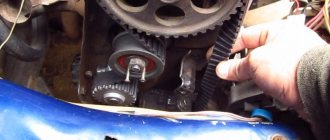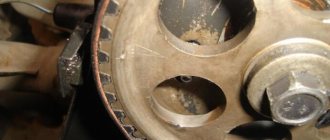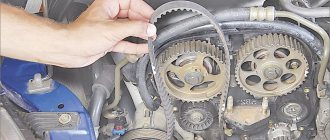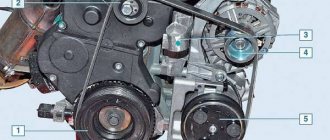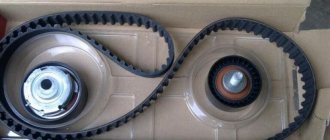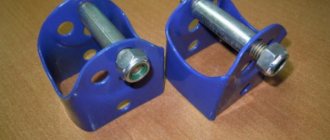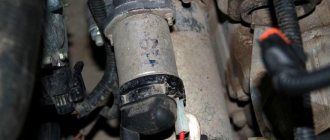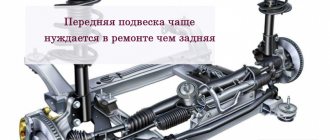Probably everyone who has encountered a 16-valve VAZ engine on a Priora knows about the problem of breakage. After which there will be expensive repairs - this is almost always the case, but there is a regulation according to which this unit must be changed after a certain mileage. The timing mechanism is a gas distribution mechanism responsible for operation by rotating the camshaft, intake and exhaust valves of the power unit.
In Priora cars with a VAZ 21126 engine (16 valves), there are 2 such shafts. The timing drive, together with the cooling system pump, is carried out by a toothed belt. The regulations for replacing the timing belt of a Priora car must be strictly observed. Unfortunately, 16 valves - of course, the dynamics of the Lada Priora car, but also the danger of a break. When a belt breaks, sad consequences arise (a bunch of bent valves, broken pistons, damage to the cylinder head). The technical regulations say about replacing the belt every 150,000 km. But experienced mechanics insist on replacing them every 50,000 - 60,000 km. due to non-compliance with the standard, with the actual service life and operating conditions. Replacing the timing belt of a Priora car can be done in a garage, with your own hands, although we must not forget about the marks on the pulleys. For one hundred, the price for replacing engine unit 126 (16 valves) is from 3,000 rubles. It is better to choose the gates brand for the timing belt itself - a set with 2 rollers is sold, its price starts from 5,000 rubles. There are cheap analogues for Priora, but you shouldn’t skimp! Read the article to the end and make sure that in a Priora car, it’s safer to do everything on time!
Timing belt on Priora 16 cl: its purpose
The timing drive part of the mechanism is made of high-quality materials. Provides synchronization of the operation of the intake and exhaust valves (16 pieces, two for intake and exhaust) with the engine operating strokes by transmitting the rotation of the crankshaft to the camshafts. At the same time, the belt drives the cooling system pump (pump). For improved adhesion to the surface of the pulleys, to avoid displacement along the camshaft marks on the inside, it has a toothed structure.
Standard belt - article number, price. Priora cars with engine 21126 are equipped at the factory with a LADA brand part, article No. 21126-1006040-00, 22mm wide. has 137 teeth, 22mm wide. Price is approximately from 1800 - 2200 rub.
Manufacturer's terms
The vehicle operating instructions recommend replacing the timing belt, tension roller, and pump after 200 thousand kilometers.
How long it actually takes to replace it depends on many factors. If the car drives most of the time on country highways without traffic jams, sudden acceleration and braking, the belt can last 200 thousand kilometers. Aggressive driving style, traffic jams, poor-quality consumables and maintenance reduce the actual service life of the timing belt.
Experienced owners of this model and repairmen recommend replacing it after 50–60 thousand kilometers. You need to check the condition of the timing mechanism parts every 10–15 thousand km.
Particular attention should be paid not only to the tension of the timing belt in the timing drive, but also to the condition of its teeth. It is their cutting that causes breakdowns followed by expensive repairs.
Belt
This part in the timing mechanism drive transmits rotation from the crankshaft, two camshafts, and the coolant pump. The loads on the belt are large; high demands are placed on the quality of the material for its manufacture. It is quite difficult to break the body of the belt; most often its teeth are cut off.
Replacing the timing belt: instructions
Let us note a slight difference in the procedure for replacing the belt on a Priora with and without air conditioning. You will need to first remove the belt and tensioner pulley of the generator (not to be confused with the timing tensioner) in order to dismantle the protective covers of the drive of the timing mechanism itself.
- Using a 15 mm socket, unscrew the tension roller of the generator, remove the belt itself (it is recommended to replace it together with the timing belt), access is open;
- Using a T-30 bit (asterisk), or a hexagon, unscrew 5 bolts of the upper cover (plastic casing) and 2 bolts of the lower timing drive cover;
- Disconnect the crankshaft sensor by disconnecting the corresponding chip located near the top cover;
- If it is necessary to replace the cooling system pump, you will have to lift the right drive wheel into the air with a jack. All this is needed to compare the marks of the camshaft pulleys with the marks on the block body;
- We rotate the raised wheel in 5th gear, or turn the crankshaft pulley with key number 17. Having matched the camshaft marks with the marks on the block body, it is necessary to turn on the neutral gear to avoid failure of the mark settings. Check the markings on the flywheel by removing the rubber plug at the top of the flywheel housing. Under the plug you can see part of the flywheel and the crown on it; align the flywheel mark with the triangular mark on the left side of the housing;
- If it is necessary to replace the pump, at this stage it is necessary to loosen the fastening of the 2 camshaft pulleys in order to avoid deformation of the valves when the gas distribution consumable is dismantled;
- To gain access to the crankshaft pulley, you need to turn the steering wheel as far as possible to the right or remove the wheel. You will need an assistant to remove the crankshaft pulley. Engage 5th gear, hold down the brake pedal, and use a 17mm key to unscrew the fastening bolt;
- ATTENTION! Left hand thread! Remove the pulley and thrust washer. Head 15mm;
- Unscrew the bolts securing the tension and thrust rollers, after dismantling which you can remove the timing belt. Install a new timing drive consumable. You need to apply tension by turning the tension roller with an offset center (the cutouts of the race and the tension roller bearing bushings must match). When reassembling, carefully monitor the marks on the camshaft pulleys and engine flywheel.
When replacing a part, the support and tension rollers are immediately changed - yes, the engine on the Priora is like that.
Adjust the tension to ensure maximum mileage
Normal belt tension
What is the best way to adjust the timing belt tension? To do this, take pliers to remove the locking rings and insert the ends into the grooves from the outer race of the roller (tensioner). The belt is tensioned, while using pliers you need to turn the tension roller counterclockwise so as to align the cutout of the outer race with the protrusion of the bushing (rectangular). The roller mounting bolt is tightened with a wrench. It is worth noting that the spare timing kit does not include anything other than a belt and rollers, so all keys and sockets must be purchased separately.
How to complete the installation of this element? After installing the pulley from the generator drive, you need to rotate the crankshaft by the mounting bolt 2 turns (clockwise) and check the alignment of all marks. If there is a discrepancy, then all operations must be carried out again, because no matter how high-quality the timing belt itself is, it will not be able to perform its functions if it is poorly installed. After all the operations and reassembly of the parts, you need to start the machine and let it run for about a quarter of an hour.
Next, you need to re-check the belt tension: when a force of 100N is applied to the middle of its long part, the “sag” should be in the range of 5.5 to 6 millimeters. If you are not confident in your experience in carrying out such work, it is better to contact a car service center that specializes in Priora, so that later you do not have to pay for the repair of the entire engine. But it’s worth having basic knowledge of how to tension a belt, because this part often fails on the highway, far from service stations, even if the car has low mileage.
Weak link: pump, roller, belt
The reasons for repairing the timing unit are most often broken bearings of the tensioner roller and pump, as well as the timing belt. The pump also has to be changed if the seal of the structure is lost, causing loss of coolant. To replace it, you will have to remove the camshaft pulleys and the rear protective cover of the casing. Remove the generator roller tensioner fasteners (3 bolts), unscrew the 6 bolts (10mm) securing the casing, two of which are located under the camshaft pulleys. After removing the casing, unscrew the 3 bolts securing the pump.
The marks on the pulleys must match
Why is this so important?
I think it’s no secret to anyone what happens when the timing belt breaks, but perhaps there are those who are not in the know. In the event of a break, the synchronization of the operation of the cylinder-piston group and valves is disrupted. The pistons begin to move towards the valves, which are no longer controlled by the belt; as a result, the pistons “meet” the valves. After such a “meeting,” the pistons are destroyed, the valves are bent, and in general you end up with a major engine overhaul. Could this have been avoided? It is possible, of course, if the manufacturer of this engine thought about this at the design stage, completely eliminating such a phenomenon. By the way, there are quite a few “plug-in” engines in the world that, after a broken belt, do not need to be “overhauled”; you just need to get to a service station and replace the timing belt. In such engines, when the valve belt breaks, the valves do not meet the pistons.
The belt and rollers must be replaced immediately if, during inspection, you find:
Separately, I would like to note the appearance of vibration and black exhaust; such symptoms, of course, can occur under other circumstances, but this option should also be considered.
Consider exclusively mileage in the question: “Is it time to change the timing belt or not?” - this is mistake. Firstly, even with low mileage, problems can arise with the belt or rollers. And secondly, there are many situations when you practically or completely do not move, while the motor is running, therefore, the belt wears out. For example, if the car is used mainly in the city, the mileage may be low, but the life of the belt itself will be at its limit, since in traffic jams the engine is running, but there is practically no movement.
There are other factors that can cause a belt to fail prematurely. For example, if oil, fuel, dirt or sand gets on it. Small particles of sand eat into the surface of the belt, destroying its surface; oil and other petroleum products soften it, reducing its strength and shortening its service life.
Be sure to watch this video: TOP 6 signs of timing belt wear
Finally.
To summarize the above, I would like to give some practical advice that will allow you to avoid timing belt rupture and, as a consequence, major repairs.
That's all for me, write in the comments when you prefer to replace and how you monitor the condition of the above-mentioned elements.
Source
When is it necessary to replace the timing belt on a Priora according to the regulations?
The mechanism requires constant attention to itself. The regulations for checking and replacing the timing belt of a Priora car with engine 21126 (16 valves) indicate regular condition checks every 10 - 15 thousand km. If you find any defects or damage to the structural integrity of the rubber part, replace it immediately.
Every 50 - 60 thousand mileage, it is necessary to change the spare part, regardless of its condition. Compliance with the regulations will help to avoid a number of extremely negative consequences that, in the most terrible scenarios, lead to almost a major overhaul of the car’s piston engine.
How often should I change
In the service manual, the manufacturer indicated that the service life of the product is 200 thousand kilometers. However, there have been cases where the product needed to be replaced after 20 thousand km or even earlier. Practice shows how many kilometers a factory strap can actually withstand: on average, this figure ranges from 120-150 thousand km.
User Ivan Bolutov spoke about the choice of original timing belts for the Lada Priora.
We recommend that you familiarize yourself with the signs that indicate the need to change the product:
Checking the condition of the belt
The inspection regulations for this unit require an inspection in a cold engine state. Remove the outer protective casing to allow visual contact with the surface of the gas distribution unit parts. Having gained access directly to the timing belt, rotating its drive, inspect both sides of the consumable in detail for the presence of any kind of defects (wear, broken teeth, protruding cord, rubber delamination, etc.). Tensioner rollers are subject to careful inspection; in the presence of mechanical damage and large play, they contribute to increased wear of the consumables. The presence of oil stains on the surface of a rubber technical part, which contribute to the destruction of its structure, is not allowed. If found, immediately remove from surface.
When to change: consequences of untimely change
It is recommended to replace the timing belt on a Priora after different periods of time. The manufacturer claims that it can withstand one hundred thousand mileage, but experience shows that a change may be needed much earlier.
The optimal period is every fifty thousand kilometers. Some argue that over such a short service life, rubber is simply not capable of failure. However, no one takes into account the conditions - roads, fuel quality, etc.
Also, during the operation of the mechanisms, it wears out, the rubber stretches, and therefore does not provide the correct tension of the timing belt, and slippage is possible. The teeth can wear off - because of this, traction with the gears is not ensured.
There is no exact time for a change that would suit all motorists. Some take good care of their vehicles, drive carefully, and use only high-quality fuel. Others use a more extreme type of driving, foreign liquids get on the rubber, etc.
In order not to lose your car during the repair period and not to spend a fortune on restoring the mechanics, write down or remember the date of the last timing belt change on the Priora. Next, regularly check the condition of the rubber; if worn, replace it with a new device.
Signs of possible failure
There are several characteristic signs that should alert the driver:
Pay attention to these “symptoms”, even if the Priora’s mileage with a new timing belt has not yet reached 50 thousand km. It may fail earlier if foreign liquid gets onto the drive - oil, coolant, as well as dust or dirt.
It’s worse if it’s the coolant that gets onto the drive. Firstly, this means that the gasket that ensures the pump is sealed has failed, or there is a problem with the pump. Then the rubber is damaged and service life is reduced tenfold.
Even if the belt is new, but coolant or antifreeze gets on it, it will fail even after operating for 10 thousand miles. You will have to replace the Priora timing belt and figure out why foreign substances get on it.
How to check the serviceability of the belt yourself
If you suspect that it is time to replace the Priora timing belt, it would not hurt to check the serviceability of this rubber product. Visual diagnostics will allow you to check the serviceability and absence of scuffs on the Priora timing belt.
About the resource
Well, now we’ve come to the most interesting thing, namely the resource. You know, now I want to talk specifically about normal belts and tensioning equipment, about “PRIORS” will be a little lower.
Not all manufacturers strictly indicate how often to change the belt, but such information can still be found, even in the car’s operating books.
The average mileage recommended for replacement is 100,000 kilometers. On many foreign cars, this mileage can be much longer, about 150,000 kilometers.
Now the question may arise: what does it depend on? Guys, to be honest, the belt itself can run (as some manufacturers claim) about 200,000 km, but its service life is reduced due to tension and support rollers. They are often the culprits of the cliff!
The support roller is a kind of bearing on which the belt rests, often has a plastic housing.
The tension roller is almost the same plastic bearing, only it is located on a special mount that “tensions” the belt, that is, it keeps it in “tone” and prevents it from “sagging” and jumping onto a tooth.
Both videos must be of simply excellent quality, no, they simply must! With foreign cars this is almost always the case, these “support” and “tensioner” last a long time, and replacement is 100 - 150,000 km in advance.
If one of the rollers stands up, the belt wears out, within some 100–200 km of travel, or maybe even less.
As you may have guessed, not only the belt is changed, but also the tension and support rollers - THIS IS MANDATORY, REMEMBER THIS! As an indirect reason for a future replacement, there may be noise from the timing drive; when the rollers begin to “bend”, they begin to make noise.
About Lada Granta engines
One of the main engines installed on these models is the 8-valve VAZ-11185-50. This is an improved VAZ-2111, with a power of 82 horsepower. It is installed on sedans and hatchbacks. Advantages of VAZ - 11185-50:
- reliability and environmental friendliness have increased;
- cravings have increased;
- When the timing drive breaks, the valves do not bend.
- increased noise;
- the need for frequent valve adjustments;
- burnout of one of the valves;
- violation of the integrity of the gasket.
Grant's car "Norma" is equipped with an 8-valve VAZ-21116 unit. This is a modified and improved VAZ-21114. Advantages:
- low noise level;
- power growth. With this engine you can reach speeds of up to 167 km/h, and acceleration to 100 m in 12.4 s;
- noticeable fuel savings.
- lower engine life;
- fragility of the pistons. Installation is lighter than that of its predecessor. For this reason, they can fail when meeting the valves;
- When the timing drive breaks, the valves bend.
Granta "luxury" is equipped with a VAZ-21126 engine. This is a 16-valve engine with a power of 72 kW (98 hp) - a direct successor to the VAZ-21124. Advantages:
- impressive dynamic characteristics. Acceleration to 100 m in 11.4 s.
- bending of valves when meeting the pistons.
Grant's cars are also equipped with a VAZ-21127 power unit with a power of 106 hp.
- lack of a mass air flow sensor, instead of which an absolute pressure sensor is installed;
- increase in power;
- good low-end traction;
- gas distribution mechanism DONS.
- unable to quickly gain momentum in higher gears;
- noise during operation;
- bending of valves when the belt breaks.
VAZ cars: repair, maintenance, tuning
Replacing the timing belt on a 106-horsepower 16-valve Lada Granta 1.6 service will cost approximately $40-45. This seems like enough incentive to roll up your sleeves and replace the belt yourself. The whole job will take no more than an hour and a half and does not require any special skills.
Causes and consequences of a break in the timing mechanism drive
The reasons may lie in the following:
- Untimely replacement of a worn out drive.
- The belt tensioner or pulley is jammed.
- Natural “aging” of the belt material.
- Oil getting on the drive surface.
- Initial low drive quality.
- Defects in the form of cracks that appear during operation.
- Climatic conditions.
- Manufacturing defects.
Consequences of a break:
- Damage to valves.
- Failure of pistons and cylinder heads.
- Stopping the camshaft and crankshaft.

